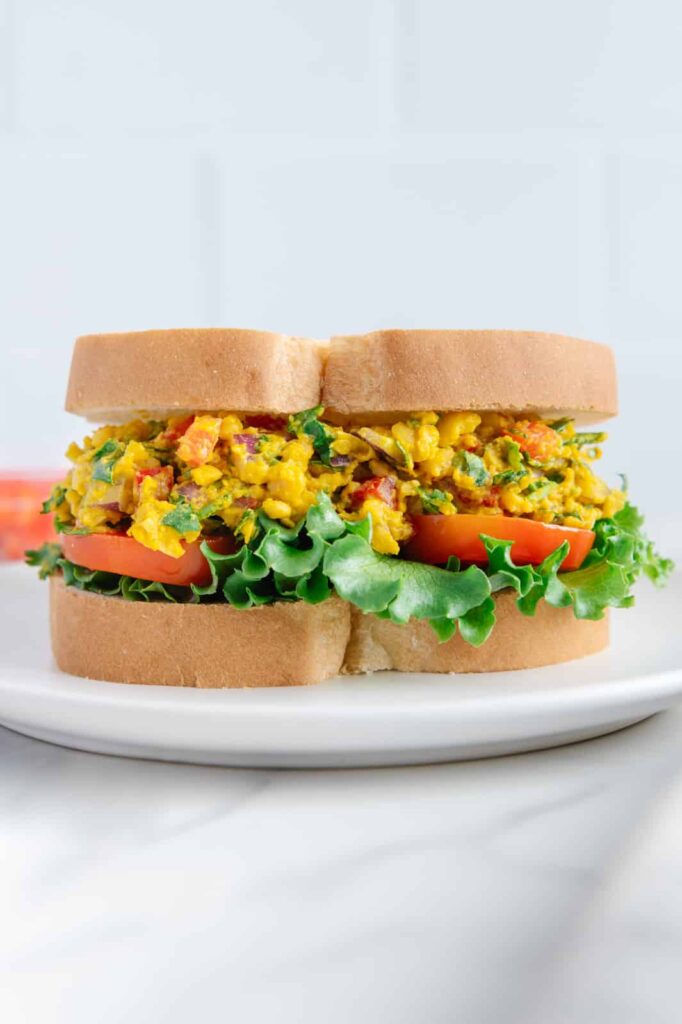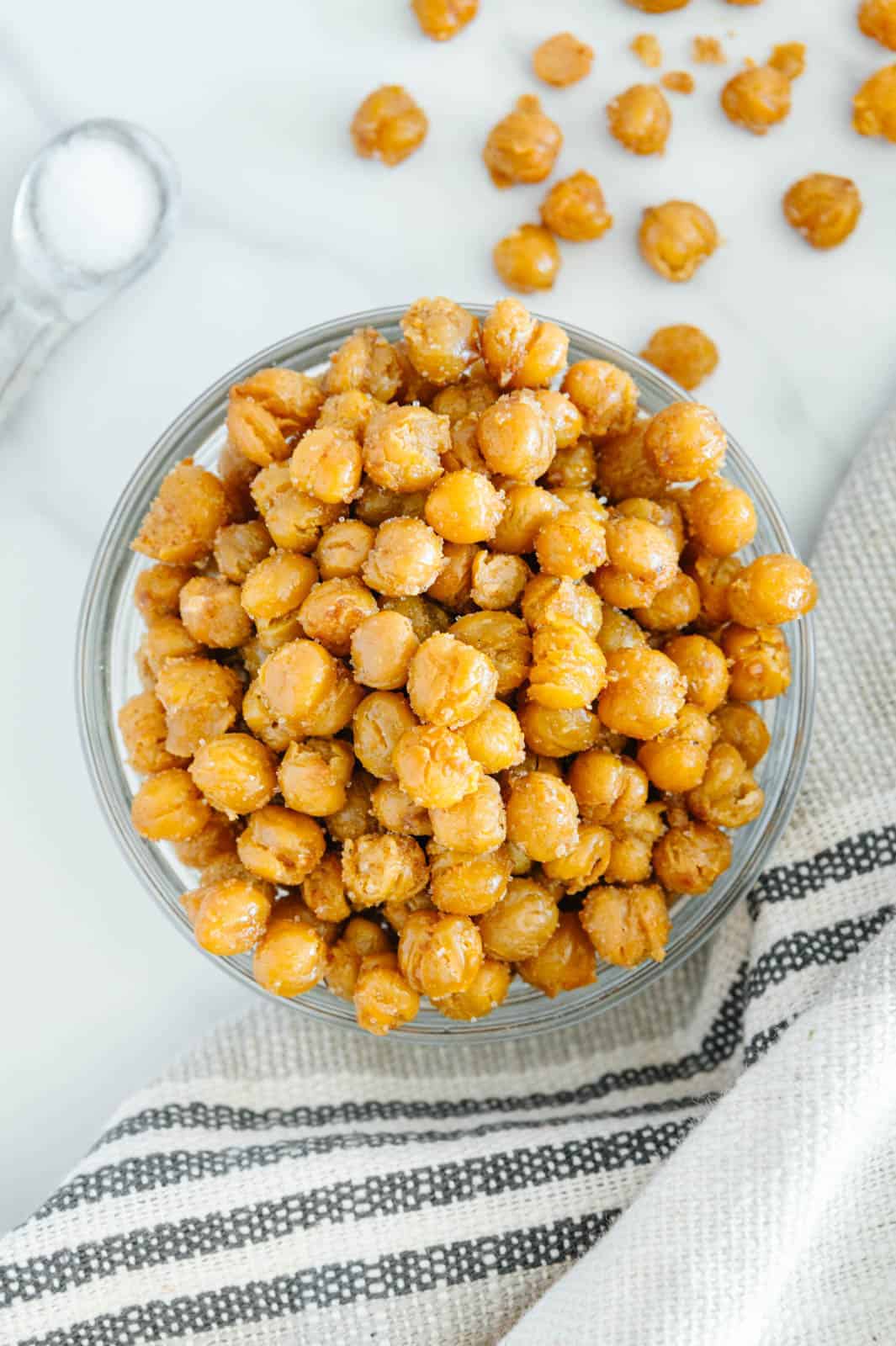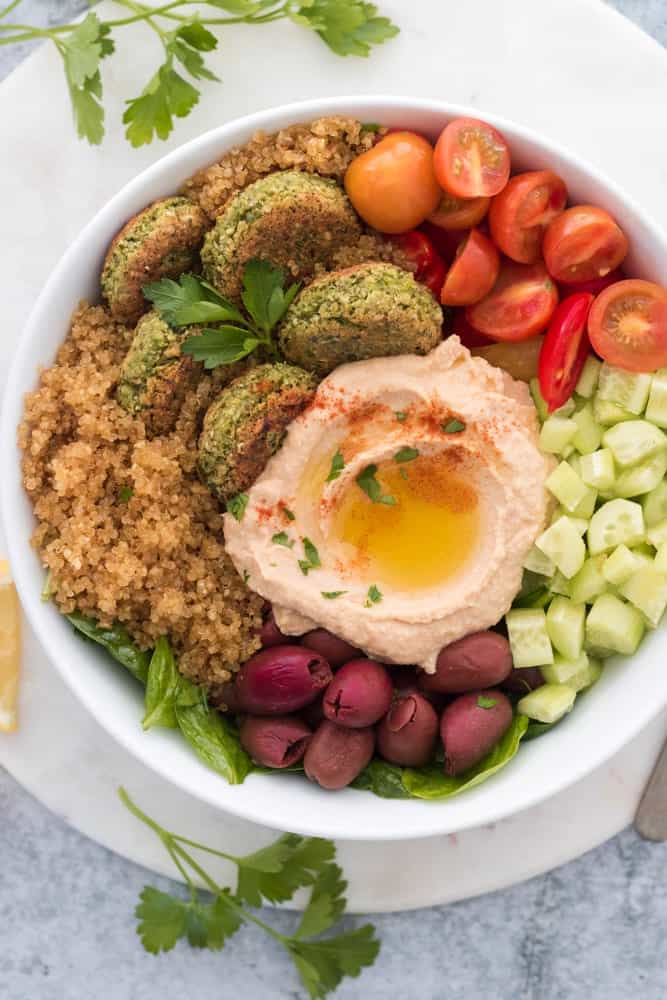Chickpeas, also known as garbanzo beans, are a delicious legume packed with protein and fiber. They are extremely versatile as they can be cooked in a variety of ways and used in salads, dips, spreads, soups, sandwiches or even as a stand-alone snack! Here, I'll cover all the health benefits, discuss canned versus dried chickpeas, describe how to cook them and share my favorite recipes to put them to use.



Table of Contents:
- Background on Chickpeas
- Health Benefits of Chickpeas
- Canned versus Dried Chickpeas
- How to Cook Dried Chickpeas
- Should You Soak Chickpeas Before Cooking?
- How Do you Store Cooked Chickpeas?
- Do You Need to Cook Chickpeas for Falafel?
- Should You Peel The Skin Off Chickpeas?
- What is Aquafaba?
- Vegan Chickpea Recipes

Background on Chickpeas
Chickpeas are an old world pulse which means they are a type of edible seed. India is currently the world's leading producer of chickpeas but they are grown in over 50 countries!
Chickpeas are a great addition to many plant-based recipes. Although mostly neutral in flavor, they have a very subtle nutty and buttery flavor and when pureed they have a creamy texture that is perfect for hummus and other dips.
Health Benefits of Chickpeas
Chickpeas are a nutritious staple in vegan diets. They are an excellent source of plant-based protein, dietary fiber, complex carbohydrates, B vitamins (such as folate) and important minerals. They are also a good source of manganese, iron and zinc. Plus, they are low in fat and contain no cholesterol. See the nutrition facts for both canned chickpeas and cooked dried chickpeas from the U.S. Department of Agriculture (USDA).
Eating chickpeas is an easy way to meet the recommended 1.5 cups of legumes per week - just ¼ cup of hummus (which is about 100 calories) per day amounts to almost 2 cups of legumes per week! Plus, it helps meet our needs for essential vitamins and minerals.
Protein in Chickpeas
Since legumes have a similar nutrient profile to both vegetables and protein foods, they may often be used to fulfill requirements of both food groups. Legumes are known as an excellent source of dietary protein. While the proteins present in legumes are not considered “complete” as compared to most animal-derived proteins, when combined with foods such as whole grains (e.g., whole grain bread, rice), a balanced intake of essential amino acids can be easily achieved.
Fiber in Chickpeas
Foods high in fiber can help promote feelings of fullness by slowing down digestion and adding bulk to meals. I love incorporating chickpeas and other legumes into my diet because the combination of plant-based protein and fiber keeps me feeling fuller longer. Studies have shown that consuming legumes such as chickpeas daily help with weight loss (source).
Positive Effects of Chickpeas on Health Conditions
In addition to their nutritional benefits, chickpeas can also positively affect cholesterol and diabetes, among other health conditions.
Cholesterol: Chickpeas can help to lower cholesterol levels as they contain a plant sterol that interferes with the body's absorption of cholesterol. Plus, the fiber and unsaturated fats may also favorably affect blood lipid levels (source).
Diabetes: Research shows that because chickpeas have a low glycemic index and low glycemic load (and contain amylose, a resistant starch that digests slowly) they play a beneficial role in glucose and insulin regulation. They help to prevent sudden surges in blood sugar and insulin levels, which can improve overall blood sugar control in people with type 2 diabetes (source).
Additionally, when eaten as part of a balanced plant-rich diet, chickpeas may help prevent the development of various chronic diseases and even help prevent colorectal cancer (source).

Canned versus Dried Chickpeas
Chickpeas are widely available canned or dried. Canned chickpeas retain most of their nutritional value and are comparable in nutrition to dried chickpeas (source). The protein and fiber content are similar for both, but the folate content in dried chickpeas is significantly higher than canned.
Using canned chickpeas is definitely more convenient because they are already cooked, allowing for them to be incorporated into recipes both easier and faster. Additionally, many recipes are tested using canned chickpeas and results for some recipes may vary when using canned versus dried and cooked chickpeas. This is due to the texture/firmness variations. If you use canned chickpeas, look for low or no sodium cans and always rinse them well. Rinsing removes about 40% of the sodium!
I also look for cans where the only ingredients are garbanzo beans, water and salt. I try to avoid any added coloring, artificial ingredients or preservatives. You would be amazed when looking at the ingredients - some brands contain a lot of unnecessary additives!
That being said, if you have the time to cook dried chickpeas you'll find they are more flavorful than canned, in addition to being less expensive and free of preservatives. And, you can control the texture based on how long you cook them. If you use dried chickpeas it is recommended to soak them to reduce bloating when they are consumed.
Do you ever cook canned chickpeas?
Yes! Even though canned chickpeas come pre-cooked, when making hummus I like to boil the chickpeas from the can to overcook them. This helps to make the hummus creamier and also helps to loosen the skin from the bean. More on that below!

How to Cook Dried Chickpeas
Chickpeas can be cooked on the stovetop or in the Instant Pot. I actually prefer the stovetop method because I am unable to check on the beans while in the Instant Pot. The necessary time it takes to cook chickpeas varies based on the size of the bean as well as the freshness (older beans tend to take longer), so using the stovetop method allows for me to monitor their tenderness as they cook.
The first step in cooking dried chickpeas is to figure out how much you need. The ratio is roughly 1:2.5, meaning one cup dried chickpeas will make around 2 ⅕ cups cooked chickpeas. So if you cook one cup of dried chickpeas, it will more than double to 2.5 cups when cooked.
Cooking Chickpeas on the Stovetop
Using the stovetop is actually really easy. After soaking (optional), draining and rinsing the chickpeas, put them into a large pot and cover with water. For one cup of dried chickpeas, I recommend using at least 3 cups of water. Bring the water and chickpeas to a boil and then let them simmer while covered until tender.
For fresh beans it should take around 60 minutes, but it could take up to 90 minutes for older beans. Unsoaked chickpeas will take slightly longer than soaked chickpeas. Either way, I recommend checking on their tenderness every 15 minutes after the 60 minute mark until cooked to your liking. You can add more water if further cook time is needed.
I actually vary my cooking style of chickpeas depending on what I'm using them for. I will slightly overcook them when using for hummus, but when using them whole I prefer them just fork tender.
Cooking Chickpeas in the Pressure Cooker (Instant Pot method)
One benefit of using the Instant Pot is that you do not need to soak the chickpeas in advance (although it does save time if you do). If you do not soak the chickpeas, add 1 pound of dried beans (about 2 cups) to a pressure cooker with 7 cups of water. Cook using high pressure for 60 minutes and then release the steam naturally for 10 minutes. Once the remaining pressure vents you are good to go!
If the chickpeas are already soaked, follow the same steps as above but reduce the cooking time on high pressure to 50 minutes.
Should You Soak Chickpeas Before Cooking?
Some say that soaking chickpeas is necessary. In addition to helping them cook slightly faster, soaking softens the beans and actually makes them easier to digest. This is because soaking reduces the amount of oligosaccharides which for some can cause bloating.
Believe it or not, I actually prefer NOT to soak chickpeas before cooking. I've experimented with soaking several times using both methods described below, but both require effort and the difference between soaked and non-soaked chickpeas after being cooked is negligible in my opinion. For me I feel soaking just isn't worth it.
If you do choose to soak though, start by sorting through the beans and removing any small stones or debris. Rinse them well and then place the chickpeas in a large bowl of water for at least three hours (or overnight). Make sure the water covers the beans by 2-3 inches because they will absorb the water and expand a good bit.
If you don't have that much time, a faster way to soak chickpeas is to boil them for 2 minutes, turn the heat off and soak with the lid on for about one hour.
How Do You Store Cooked Chickpeas?
You can store cooked chickpeas in the refrigerator for up to 5 days. I don't believe freezing them is worth the effort, but they can be stored in the freezer for up to 3 months. If you freeze them, make sure to separate each chickpea on a parchment-linked baking sheet first, and once frozen feel free to then transfer them all to a freezer bag for more compact storage in your freezer.
You can thaw frozen chickpeas overnight in your refrigerator before using. Once they are thawed out you should store in your refrigerator and use within 3-4 days.

Do You Need to Cook Chickpeas for Falafel?
No! Traditional falafel recipes actually have you soak the chickpeas overnight and then throw them into a food processor once drained, rinsed and dried. This method of making falafel uses softened (but not cooked!) chickpeas. The texture is MUCH better with this method and it is the more authentic way to make falafel.

While you can make falafel using canned chickpeas (which are pre-cooked) it will be a bit mushier. If you do, just be sure to add oat flour or another flour to help absorb some of that extra moisture. This will help make the falafel more sturdy.
Should You Peel the Skin Off Chickpeas?
Removing the skin from chickpeas can make a huge difference in certain recipes. This is actually the secret to the perfect hummus because it makes the chickpeas super creamy.






It is also best practice to remove the skin when roasting chickpeas in order to make them crispy. Otherwise, the skin locks in moisture and makes them soggy when roasted.
How to peel the skin off chickpeas
There are several ways to take off the skin:
- Strain the chickpeas and thoroughly dry them with a kitchen towel while still in the strainer. The skins will naturally fall off as you gently press the chickpeas into the strainer using the towel.
- Cook the chickpeas on the stovetop using 1-2 teaspoons of baking soda in the pot. The baking soda is a leavener and raises the pH level of the water. This makes the chickpeas more soluble and they cook more quickly. It also helps to naturally separate the skin from the chickpeas for a ethereally smooth texture. You can then discard the separated skins after you drain the chickpeas.
- Manually pinch the skin off each chickpea. Pinching the fatter part of the chickpea makes it a little easier. This method is a little monotonous but it is the easiest in my opinion and definitely worth it!
What is Aquafaba?
Aquafaba is the thick starchy liquid from a can of chickpeas. It contains trace amounts of protein and is flavorless and odorless. Aquafaba is also produced when you cook dried chickpeas if you save the cooking water. It is starchy and when whipped it emulsifies and can be used as an egg replacer, making it a great option for vegan recipes such as muffins and waffles.
Aquafaba amazingly can also be whipped into a foam. The foam can be used for many desserts such as egg-free meringue, vegan mayonnaise, vegan whipped cream or vegan chocolate mousse. This is a great opportunity to upcycle and avoid food waste.

One tablespoon of aquafaba is equal to one egg yolk, and two tablespoons are equal to one egg white. Three tablespoons is equal to one whole egg.
There is no recipe for aquafaba - just save the liquid from the can!
Vegan Chickpea Recipes
Chickpeas are incredibly versatile and run the gamut in terms of recipes they can be used in.






Here are some of my favorite easy chickpea recipes:
- Crispy Roasted Chickpeas
- Hummus
- Appetizers
- Soups, Salads and Sandwiches
- Best Chickpea Soup for the Soul
- Moroccan Tomato Chickpea Soup
- Spicy Red Lentil Veggie Stew with Crunchy Chickpea Croutons
- Best Vegan Kale Caesar Salad with Chickpea Croutons
- Plant Powered Fall Quinoa & Arugula Salad with Apples & Figs
- Classic Vegan Chickpea Salad
- Curried Chickpea Salad
- Vegan Chickpea & Avocado "Egg" Salad Sandwich
- Rainbow Veggie Hummus Wraps with Dipping Sauce
- Jennifer Aniston Viral "Perfect Salad"
- Entrees
- Vegan Butter Chickpeas (Indian Butter Chickpeas)
- Vegan Cauliflower Chickpea Shawarma Bowls
- Roasted Veggies & Crispy Chickpeas Over Fluffy Quinoa
- Cauliflower Steak Marbella with Roasted Chickpeas
- Easy One-Pot Vegan Pumpkin Curry
- Easy Moroccan Chickpeas
- Vegan Chickpea Bolognese Pasta
- Vegan Cauliflower Chickpea Shawarma
- Instant Pot Cauliflower & Chickpea Tikka Masala
- Easy Vegan Tikka Masala
- Vegan Greek Sheetpan Dinner
- Easy Vegan Sweet Potato Curry
- Crispy Quinoa Falafel Bowls
- Homemade Gluten-Free Chickpea Flour Pizza Crust (this is also the base for my Pizza with Pesto and Roasted Beet Noodles)
- Quick & Easy One-Pot Curried Quinoa & Chickpeas
- Easy Vegan Stuffed Sweet Potatoes
- Vegan Mediterranean Quinoa Bowl
- Easy Whole Roasted Rainbow Carrots over Hummus with Herb Tahini Sauce
- Dessert (yes, seriously!)
For more on chickpeas, check out my post on Pantry Staples That Do It All: Over 30 Chickpea Recipes. And comment below with your favorite way to incorporate chickpeas into your diet!

Leave a Reply